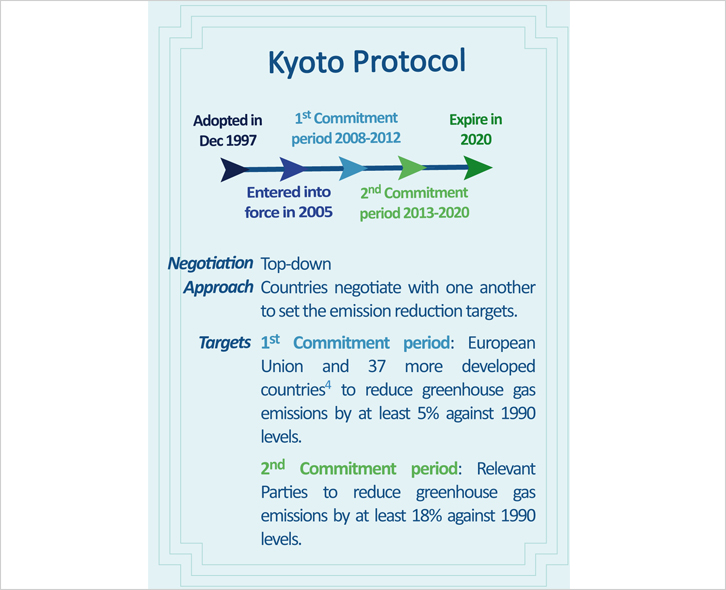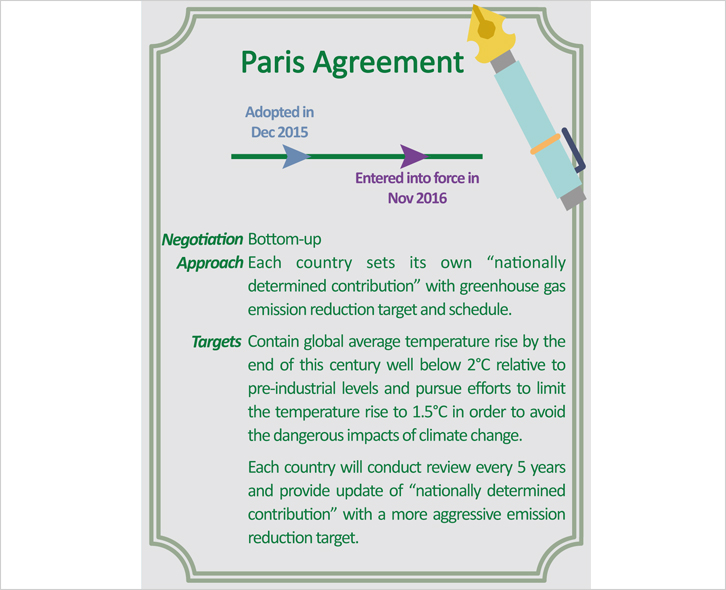International cooperation
The Intergovernmental Panel on Climate Change (IPCC) was established by the World Meteorological Organization (WMO) and the United Nations Environment Programme (UNEP) in 1988. On a regular basis, IPCC reviews most up-to-update scientific literature on climate change and prepare assessment reports, providing clear scientific perspectives and objective information to the world, including the scientific bases and causes of climate change, its potential environmental and socio-economic consequences, and the adaptation and mitigation options to respond to the impacts.
The United Nations Framework Convention on Climate Change (UNFCCC) was adopted during the Rio de Janeiro Earth Summit in 1992. It is an international environmental agreement which aims at stablising the level of atmospheric greenhouse gases in order to prevent dangerous interference to the climate system due to human activities. To achieve this goal, two important international agreements were adopted by the United Nations, namely, the Kyoto Protocol in 1997 and the Paris Agreement in 2015.
The Kyoto Protocol
In 1997, the 3rd session of the Conference of the Parties (COP 3) of UNFCCC took place in Kyoto, Japan and adopted the Kyoto Protocol. But the Protocol did not enter into force until 2005.
The Kyoto Protocol recognizes the principle of “common but differentiated responsibilities”, meaning that combating climate change is a responsibility commonly shared by all nations. However, since more developed countries [1] are principally responsible for the current high levels of atmospheric greenhouse gases as a result of more than a hundred years of industrial activity, the Protocol places a heavier burden on more developed countries than less developed countries [2] in emission reduction.
A top-down approach was adopted in negotiating the emission reduction targets among the more developed countries. It is difficult to implement the agreement because each country has to consider its own circumstances and economic interests.
The emission reduction commitment period of the Kyoto Protocol was 2008 – 2012. The European Union and 37 more developed countries [3] pledged to reduce at least 5% greenhouse gas emissions against 1990 levels.
In 2012, the Doha Amendment to Kyoto Protocol was adopted at the 18th session of the Conference of the Parties (COP 18) of UNFCCC. The 2nd commitment period of 2013 – 2020 was adopted. Relevant Parties pledged to reduce their greenhouse gas emissions by at least 18% against 1990 levels.
[1] Teachers reference: Referred as Developed Countries by UNFCCC
[2] Teachers reference: Referred as Developing Countries by UNFCCC
[3] Teachers reference: Referred as Industrialized Countries by UNFCCC
Effectiveness of the Kyoto Protocol
There are criticisms of the effectiveness of the Kyoto Protocol, citing the lack of participation of some more developed countries. For example, the United States in 2001 declared that it had no intention of implementing the Kyoto Protocol, and Canada formally withdrew in 2012.
During the 1st commitment period from 2008 to 2012, some more developed countries achieved the emission reduction targets while some did not.
Fig 5.1 Emission reduction pledges for the 1 st commitment period and actual emissions of some countries
Other criticisms are directed towards the principle of “common but differentiated responsibilities”. Under this principle, less developed countries are not required to share the responsibility of emission reduction. However, increased emissions from less developed countries have offset the reductions made by more developed countries.
The Paris Agreement iii
In 2015, the 21st session of the Conference of the Parties (COP21) of UNFCCC took place in Paris, France and adopted the Paris Agreement.
The main goal of the Paris Agreement is to contain global average temperature rise by the end of this century well below 2°C relative to pre-industrial levels and to pursue efforts to limit the temperature rise to 1.5°C in order to avoid the dangerous impacts of climate change. The Paris Agreement entered into force in November 2016 and was later ratified by 181 iv Parties as of September 2018.
Unlike the Kyoto Protocol, the negotiation in the Paris Agreement was based on a bottom-up approach. Each country compiles its own “nationally determined contribution” with greenhouse gas emission reduction target and schedule according to its national circumstances. Each country will conduct review every 5 years and provide update of “nationally determined contribution” with a more aggressive emission reduction target. Since the countries determine their own emission reduction targets, it is easier to implement the agreement.
Table 5.2 Emission reduction targets of some Parties v
[4] Teachers reference: Referred as Industrialized Countries by UNFCCC
Special Report on Global Warming of 1.5°C
In response to one of the decisions made at COP21, the IPCC published the Special Report on Global Warming of 1.5°C in October 2018. The Special Report makes an urgent call for policymakers that limiting global warming to 1.5°C would require rapid, far-reaching and unprecedented changes in all aspects of society. The Special Report clearly presents the multiple benefits of limiting global warming to 1.5°C compared to 2°C, for example:
1. a slower rate of sea level rise which enables greater opportunities for adaptation in the human and ecological systems of small islands, low-lying coastal areas and deltas;
2. lower impact on terrestrial, freshwater and coastal ecosystems which helps retain more of their services to human;
3. lower ocean warming and acidification and hence lower risks to marine biodiversity and ecosystems;
4. lower climate-related risks to health, food security, water supply, human security and economic growth; and
5. lower adaptation needs.
Human activities have already caused approximately 1°C of global warming above pre-industrial levels and we are already seeing the consequences of global warming through more extreme weather, rising sea levels and diminishing Arctic sea ice. To contain global warming to 1.5°C, human-caused carbon emissions have to decline by about 40% from 2010 levels by 2030, reaching net zero around 2050. Current national pledges of emission reductions under the Paris Agreement would not suffice to achieve the goal. The goal can only be achieved if global carbon emissions start to decline well before 2030. Based on the “nationally determined contributions” for reductions in greenhouse gas emissions made by the countries at the Paris Agreement, a global warming of around 3°C would be more likely by the end of this century.





